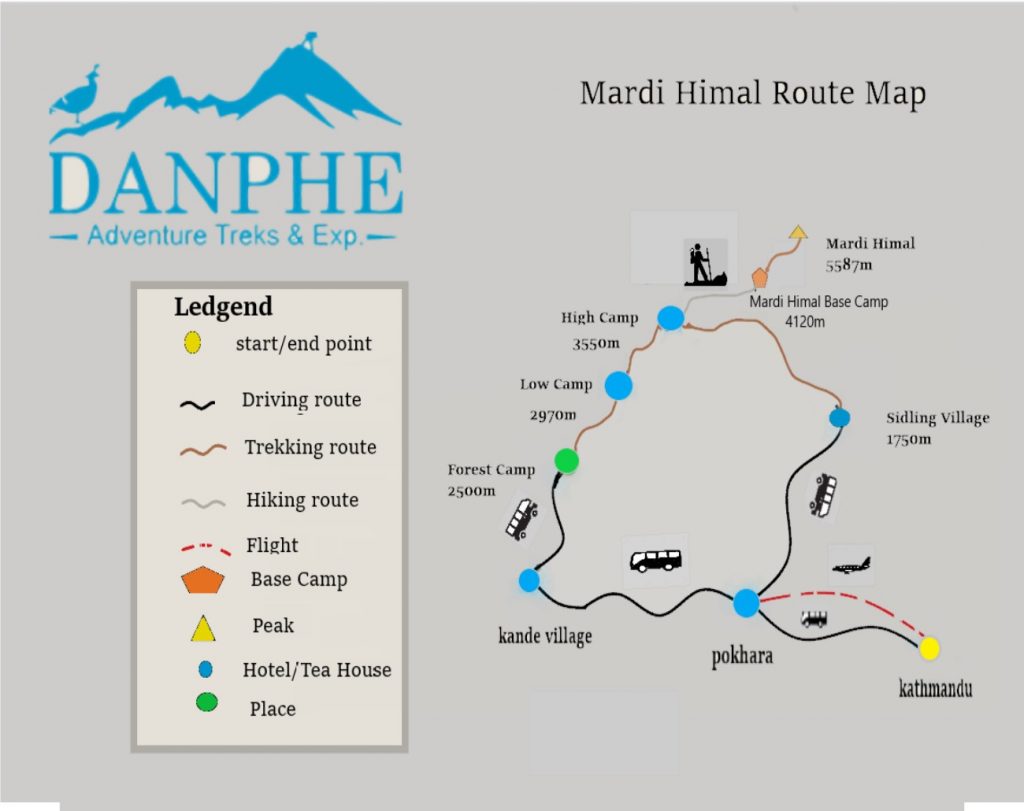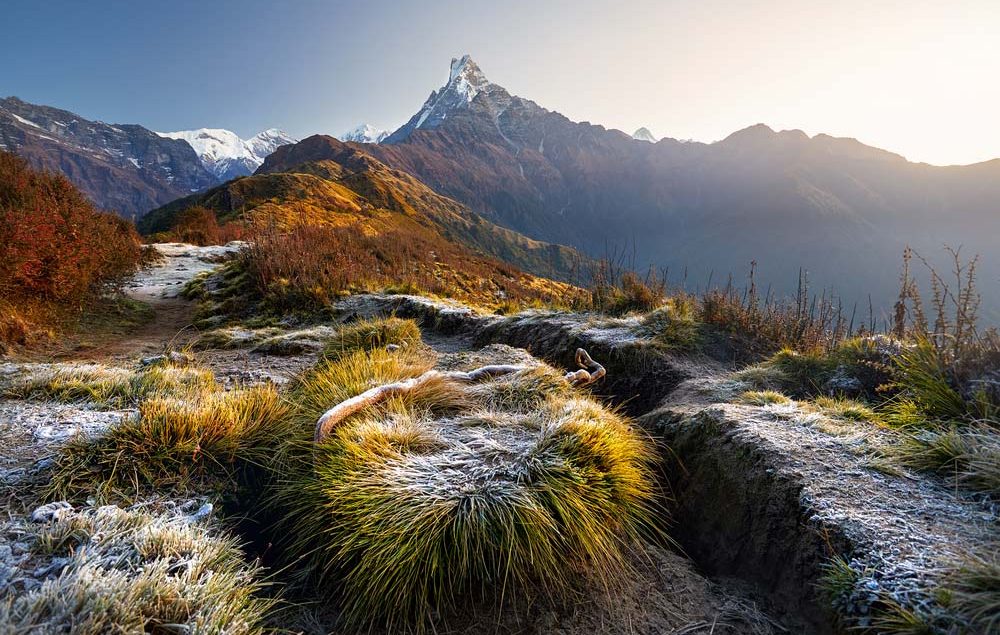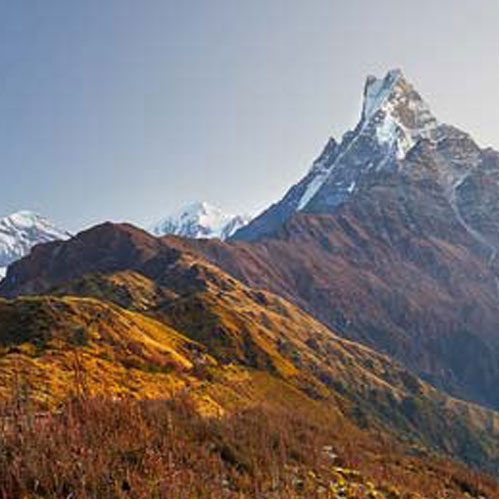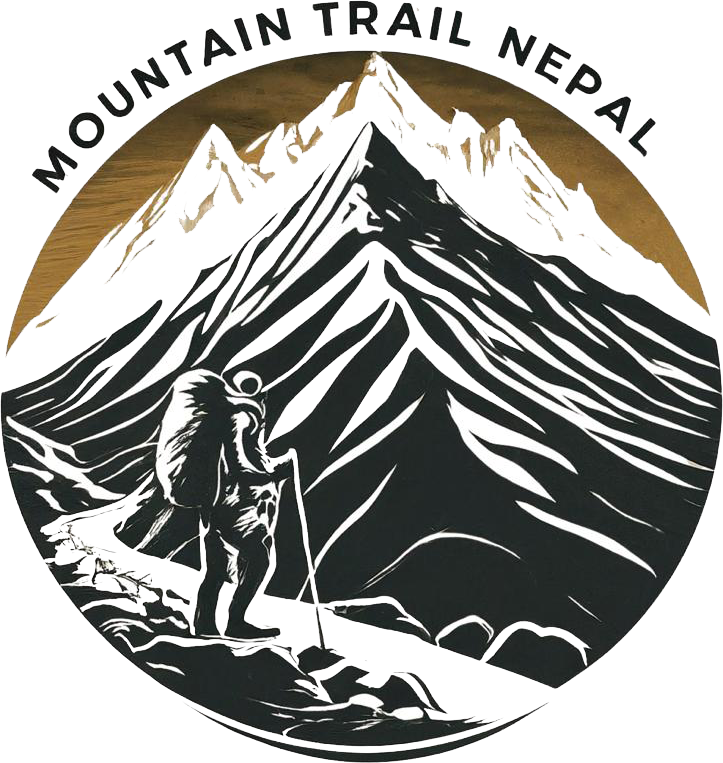Trip Highlights
- Experience the stunning trails of the Annapurna Conservation Area.
- Immerse yourself in the warm hospitality and rich culture of the Gurung community.
- Marvel at the majestic beauty of the Annapurna Peak.
Trip Itinerary
Expand All
Shrink All
-
Day 01: Arrival in Kathmandu (1300m)
Upon your arrival at Tribhuvan International Airport, you’ll be greeted by one of our representatives who will accompany you to your hotel. Once you’ve settled in, you’ll have the opportunity to meet your trek guide and have a chat about the upcoming adventure. After that, you can explore the nearby shops to get any gear or equipment you might need for the trek. Rest up for the night at the hotel in Kathmandu.
-
Day 02: Kathmandu Sightseeing
Today, you’ll embark on an exciting sightseeing tour of the Kathmandu Valley, visiting some of its most famous UNESCO World Heritage sites. Your journey begins with a visit to Swayambhunath, also known as the Monkey Temple, where you can observe the monkeys and take in the panoramic views of the valley. Next, you’ll explore the historic Kathmandu Durbar Square, admiring its ancient temples and palaces. Afterward, you’ll visit the sacred Pashupatinath Temple, dedicated to Lord Shiva, and then conclude your tour with a visit to the serene Boudhanath Stupa, one of the largest stupas in Nepal. Finally, you’ll return to your hotel in Kathmandu for a comfortable overnight stay.
-
Day 03: Drive from Kathmandu to Pokhara | 820m
After enjoying breakfast, we’ll set off on a scenic road trip to the picturesque city of Pokhara, located to the west of Kathmandu. Our journey will take us along the Prithvi Highway, where we’ll be treated to breathtaking views of the majestic Trishuli River, lush forests, and vibrant towns along the way. As we wind our way through the serpentine roads of Nepal, you’ll have the opportunity to soak in the beauty of the surrounding landscape. Upon reaching Pokhara, you’ll be greeted by the stunning sight of Machhapuchhre (6997m) and Annapurna I (8091m) towering over the horizon. We’ll then check into our hotel in Pokhara for a relaxing overnight stay.
-
Day 04: Drive to Kande, trek to Forest Camp (2,500m)
Following an early breakfast, we’ll embark on a short 40-minute drive from Pokhara to the charming village of Kande. Once there, we’ll take a brief rest before starting our trek towards Mardi Himal. Our journey will lead us through the lush forests of the Annapurna region, ascending towards Australian Camp. Here, we’ll pause to take in the breathtaking panoramic views of the Annapurna range and the picturesque Pokhara valley. After soaking in the scenery, we’ll continue our trek through the forested ridge until we reach Forest Camp, where we’ll spend the night.
-
Day 05: Trek to Low Camp (2,970m)
Continuing our journey, we’ll follow the trail as it gradually ascends through the enchanting rhododendron forest towards Low Camp. Along the way, you’ll be surrounded by the vibrant colors of the forest, and if we’re lucky, we may even catch glimpses of local wildlife. Low Camp boasts a few cozy tea-houses, and from this vantage point, we’ll be treated to stunning views of Machhapuchhre (6997m) and Mardi Himal (5553m), which seem tantalizingly close. For those eager for an even clearer perspective, we have the option to trek for an additional hour towards Badal Danda, located just above Low Camp, where we can enjoy an even more spectacular view of the mountains. We’ll spend the night at Low Camp, surrounded by the tranquility of the mountains.
-
Day 06: Trek to High Camp (3,550m)
As we continue our trek, the trail gradually ascends closer to the ridge leading to Mardi Himal and Machhapuchhre. Leaving behind the lush forested surroundings of Low Camp, we’ll enter a shrubby alpine zone. Here, amidst the rugged terrain, we’ll be greeted by the awe-inspiring sight of snow-capped peaks, including Annapurna South (7219m), Hiunchuli (6441m), and Machhapuchhre (6997m), standing majestically in the distance. Tonight, we’ll rest at High Camp, surrounded by the serene beauty of the Himalayas.
-
Day 07: Hike up to Upper View Point (4,500m), back to High Camp
Today’s trek will be challenging as we tackle a steeper trail towards the Mardi Himal Base Camp. The ascent may take about 2 hours, requiring extra effort and endurance. Upon reaching the base camp, you’ll be rewarded with breathtaking views of the Mardi Himal summit (5553m), as well as iconic peaks like Machhapuchhre (6997m), Annapurna I (8091m), Gangapurna (7454m), and Annapurna III (7555m). For those seeking an even closer look, we can ascend for a couple more hours to reach the Upper View Point. After soaking in the panoramic vistas, we’ll descend back to High Camp for a well-deserved rest.
-
Day 08: Trek to Siding Village (1,750m)
As we descend, we’ll take a different route leading us to the charming village of Siding, situated near Low Camp. Along the way, we’ll be treated to mesmerizing landscapes, with the rich biodiversity of the Annapurna Conservation Area enhancing the beauty of our journey. Siding village, nestled amidst lush forests at the foothills of the Himalayas, offers a glimpse into traditional rural life. It’s a serene retreat where we’ll spend the night, surrounded by nature’s tranquility.
-
Day 09: Siding Village to Pokhara (820m)
Today, we’ll trek downhill to Lumre village, where we’ll catch transportation back to Pokhara City. Along the way, we’ll pass through Kalimati and Ghalel villages. Kalimati is predominantly inhabited by Brahmins, while Ghalel has a mix of Brahmin and Gurung residents. Upon reaching Lumre, a jeep will be waiting to take us back to Pokhara. We’ll spend the night at a hotel in Pokhara, reflecting on the memorable journey we’ve had.
-
Day 10: Drive to Kathmandu | Farewell Dinner
As we bid farewell to Pokhara, we embark on a journey back to Kathmandu. The majestic sights of Annapurna I (8091m) and Machhapuchhre (6997m) bid us goodbye as we traverse the scenic Prithvi Highway alongside the Trishuli River. Upon our arrival in Kathmandu, you’ll have the opportunity to explore the vibrant city and soak in its rich cultural heritage. We’ll spend the night at a hotel in Kathmandu, reminiscing about the incredible experiences we’ve had during our trek.
-
Day 11: Departure to International Airport
What's Included
- Private airport transfers in a comfortable vehicle for arrival and departure.
- Accommodation in Kathmandu with breakfast included, as per the itinerary.
- Guided cultural tour of Kathmandu with a knowledgeable guide and private vehicle.
- All meals (Breakfast, Lunch, and Dinner) provided during the trek.
- Comprehensive ground and air transportation arrangements throughout the trek.
- Experienced, English-speaking guide and porter ratio of 1 porter for every 2 trekkers.
- Staff salaries covering their food, accommodation, and transportation expenses.
- Arrangement of all necessary permits, including Conservation entry permits and TIMS card.
- Emergency helicopter service arrangement, covered by your travel insurance.
- Provision of essential trekking equipment, including sleeping bag, down jacket, and trekking map (to be returned after the trek).
- Inclusive of all government taxes, VAT, and local taxes for a hassle-free experience.
- Nepal entry visa fee ($25 USD), obtainable upon arrival at Tribhuwan International Airport in Kathmandu. Please prepare 2 passport size photos.
- International airfare to and from Kathmandu.
- Compulsory travel insurance covering the duration of your trip.
- Meals in Kathmandu, giving you the flexibility to explore local dining options.
- Entry fees for cultural tours and attractions during your stay in Kathmandu.
- Personal expenses such as alcoholic and non-alcoholic beverages, bar bills, battery charges, additional porter services, and hot water showers.
- Tips for your guide, porter, and driver, which are discretionary but highly appreciated for their excellent service
Equipment List
List of Equipments required for Mardi Himal Trek:
Head:
- Warm winter hat/beanie
- Sun hat
- Headband/buff
- Sunglasses with UV protection
- Headlamp/Torch with extra batteries
Upper Body:
- Light fleece sweater
- Heavy fleece sweater
- Quick-drying long-sleeved base layer shirts (2 pairs)
- Short sleeve trekking shirts (3 pairs)
- Wind/rainproof jacket
- Down jacket
Lower Body:
- Trekking shorts
- Trekking trousers
- Lightweight thermal bottoms (seasonal)
- Trekking pants with zip-off bottoms (2 pairs)
- Fleece or woolen trousers
- Waterproof pants
Hands:
- Lightweight warm gloves
- Poly-liner gloves
Feet:
- Trekking boots
- Sandals/trainers (for wearing around the lodges)
- Down booties
- Thin lightweight inner socks (2 pairs)
- Warm woolen or poly socks (2 pairs)
- Gaiters (only in winter)
Other:
- Sleeping bag
- Sleeping bag liner (optional)
- Trekking poles (1 pair)
- Water purification tablets/Steripen/drops
- Quick-drying towel
Feel free to adjust this list based on your personal preferences and the specific requirements of your trek. It’s essential to ensure you have the necessary gear to stay comfortable and safe during your adventure in the Nepalese mountains.
FAQs
-
What are the visa requirements?
Currently, all the foreign nationalities (except Indians) require a visa to enter Nepal. Visas are obtainable from embassies abroad or on arrival at Kathmandu’s Airport. If getting the visa at the airport be prepared for long queues. You will also need to provide one passport photo and the $50 USD fee for 30 days.
-
What are the physical requirements for Mardi Himal Trek?
Mardi Himal Trek requires you to trek at an altitude of maximum 4500m and up to 5-7 hours per day, with a small 5-7kg bag. We recommended you to train with long hikes and/or a sport of your choice (e.g. jogging).
-
How old do I need to be?
There is no age restriction for doing this trip, but if you are under 16 it will better to trek with your parents. You must be health-conscious during the trek.
-
What is included?
Included:
- Guides and Porters
- Transportation (including airport transfers)
- Accommodation
- Permits & national park fees
- Sightseeing tour in Kathmandu
- All meal during the trek
- Seasonal fruits
Excluded:
- International flights to Kathmandu
- Food – (while you are in City)
- Showers on Trek
- Tips
- Visa fees (typically $50 USD)
- Personal travel/rescue insurance
-
What is the accommodation like?
You will stay in the Hotel while you are in the city of Kathmandu, which is like a 3-star category. The hotel has access to showers and intermittent internet.
But while you are in trekking Tea House/lodges are the place where you spend the night during the trek, which is very basic. The room is pretty small with twin sharing and a common washroom. Some places have squat style toilets, whilst others have a western style. Shower does not always offer warm water and most teahouses will charge you for use of a hot shower.
-
Which meals are included?
Meals will be served as per the menu of the teahouse/lodges. Where you can find a variety of dishes like Indian, Nepalese, Tibetan, Continental, etc, to choose. Tea, coffee, bakery items, snacks, bars eggs, etc can also be found easily.
-
What currency should I take?
The currency used in Nepal is Nepalese Rupees (NPR). You are unable to get NPR outside of Nepal and therefore you will need to exchange money in Kathmandu. The easiest currency to exchange is USD and Euro. You can also withdraw NPR from the ATM but check with your bank about the relevant charges to do this.
-
Is there any Bank or ATM facility during Mardi Himal Trek?
Yes, there is a good facility of bank and ATM in Pokhara.
-
What kind of problems can arise at a higher altitude during Mardi Himal Trek?
There is a huge change of AMS problem i.e. Acute Mountain Sickness problem. It may cause some problems as you trek higher above 3500-meter altitude (11,482 ft.). But don’t worry about that. We have carefully designed our Mardi Himal itinerary with sufficient time for acclimatization and less walking time each day. And our experienced trek guide will be helping you with it.
-
Do I need insurance before the Mardi Himal Trek?
Yes, you need to be insured before the adventure trekking in Nepal from your home country. However, we will be always with you taking care of throughout the whole Mardi Himal trek.
-
What should I pack?
Documents
- Passport
- Travel insurance details
- 2 passport photos
- Cash USD
- Credit/Debit Card
Head
One Warm winter hat/beanie.
One Sun hat
1 Headband/buff.
1 Sunglasses with UV protection.
One Headlamp/ Torch with extra batteries.
Upper Body
2 pairs of Fleece sweaters- one light and one heavier
2 pairs of quick-drying long-sleeved base layer shirts
3 pairs of Short sleeve trekking shirts
1 pair of Wind/rainproof Jacket v 1 Down Jacket
Lower Body
One pair of trekking shorts
A pair of trekking trousers
One pair of lightweight thermal bottoms (seasonal)
Two pairs of trekking pants with Ziff off bottoms
One pair of fleece or woolen trousers
Two pair of waterproof pants, breathable fabric
Hands
A pair of lightweight warm gloves
A pair of poly-liner glove
Feet
One pair of trekking boots
A pair of sandals/ trainers (for wearing around the lodges)
One pair of down booties (great for keeping feet warm)
Two pair of thin lightweight inner socks
Two pair of warm woolen or poly socks
Gaiters (only in winter)
Other
One Sleeping Bag
One Sleeping bag liner (optional)
A pair of trekking poles
Water purification tablets/Steripen/Drops
One quick-drying towel
-
What is the best time of year for Mardi Himal Trek?
Mardi Himal Trek is possible for the whole year, but the best time to doing this trek is spring season (March to June) and autumn season (September to November).
However trekking in winter season to chance to see snowfall with magnificent views of mountain, and in monsoon time you will see waterfalls.



















